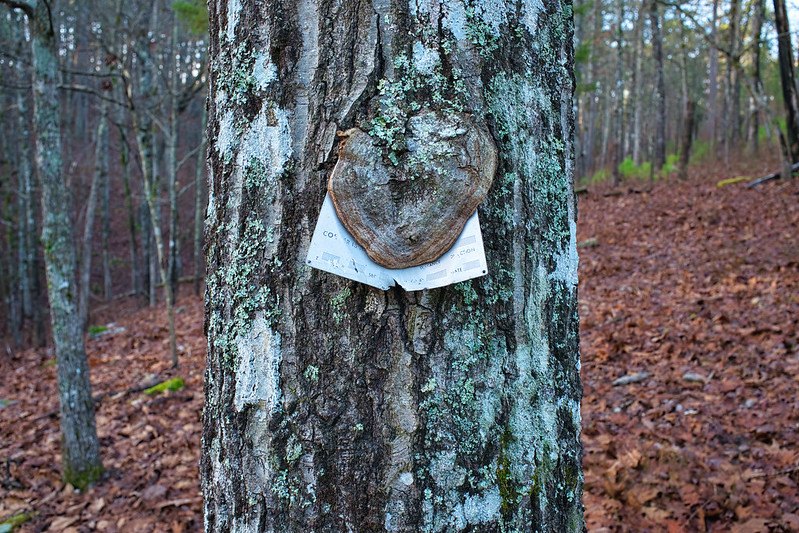While hiking in the Ouachita National Forest, I saw something amazing—a forest sign almost completely covered in tree fungus. It looked like the sign and tree had merged into one. This surprising sight made me stop and think about how nature reclaims what humans leave behind.

The Fungi: Recyclers of Fungus-Covered Signs
Fungi are incredible organisms. They break down dead plants and animals, returning vital nutrients to the soil. This keeps nature healthy and balanced. Sometimes, fungi grow in unexpected places, like signs. On this particular sign, the fungi showed their adaptability by turning it into their home.
The tree, the sign, and the fungus all seemed connected. The fungi didn’t harm the tree but highlighted how important they are to the environment. They thrive in surprising places and play a crucial role in ecosystems.
Why Fungi Thrive on Fungus-Covered Signs
Fungi love damp, moist places. Signs attached to trees often stay wet from rain and humidity, especially if they’re old or made of wood. Even metal signs can hold water in tiny cracks, giving fungi a perfect place to grow.
The Ouachita National Forest’s humid climate and shady trees create an ideal environment for fungi. Over time, the fungi break down parts of the sign, like paint or wood, and become part of the natural cycle of decay.
Lessons from Fungus-Covered Signs: Nature’s Strength
Seeing the fungus-covered sign reminded me how strong and adaptable nature is. Fungi can grow on fallen logs, damp rocks, or even man-made objects like this sign. They’re essential because they recycle materials and help keep ecosystems healthy.
The tree holding the sign wasn’t damaged. The fungus stayed on the sign and didn’t harm the tree. This balance showed how nature’s systems work together without causing harm.
How Nature Uses Human Objects
This sign made me think about how things left in nature change over time. For example, old train tracks get covered with plants, and stone walls in forests grow moss. A great example of this can be seen in this tree with a hole through it, showcasing how trees adapt to objects in their path. Similarly, fungus-covered signs remind us that nature can reclaim almost anything.
However, not all objects blend into nature. Items like plastic or harmful chemicals can hurt plants and animals. That’s why it’s important to use materials that break down naturally when we leave them outdoors.
Why Fungi Are So Important
Fungi are key to keeping forests healthy. They break down dead plants and animals, turning them into nutrients for new growth. They also help trees through underground networks that share nutrients and water.
Fungi even play a role in fighting climate change by recycling carbon. Their work in forests like the Ouachita National Forest is essential for the entire ecosystem.
Exploring the Beauty of Fungus-Covered Signs
Fungi aren’t just useful—they can be beautiful, too. On this sign, the fungi formed patterns and textures that looked almost like art. The earthy colors and unique shapes made the sign a special part of the forest’s landscape.
When you’re out in nature, take a closer look. You might find beauty in unexpected places, like a fungus-covered sign or a mossy rock.
Let’s Protect Nature
Seeing this sign reminded me how much humans affect nature. Even though this sign became part of the environment, not everything we leave behind is helpful. Plastic and other materials can take decades to break down and often harm wildlife.
We should choose eco-friendly materials for signs and outdoor equipment. By using items that break down naturally, we can help nature thrive instead of harming it.
Humans and Nature: A Special Connection
The Ouachita National Forest shows how connected humans and nature are. From fungus-covered signs to trees growing through old structures, nature adapts to what we leave behind. It’s our job to make sure we leave as little harm as possible.
A Thoughtful Moment in the Forest
This experience in the forest made me think about how nature reclaims what humans leave behind. Whether it’s a fungus-covered sign or a tree taking over an old trail, nature’s resilience is amazing.
Next time you’re in a forest, look closely at the world around you. You might find something ordinary turned extraordinary by nature. For instance, take a look at this tree with a hole through it to see another incredible example of how nature adapts to its surroundings. You never know what surprises are waiting just off the trail.
FAQs
What makes fungi grow on signs? Fungi grow best in damp, humid places. Tree-mounted signs hold moisture, especially if they’re damaged or made of wood.
Do fungi on signs hurt trees? Usually, fungi on signs don’t hurt the trees. In this case, the fungi stayed on the sign and didn’t harm the tree.
Why are fungi important to forests? Fungi break down dead plants and animals, recycling nutrients into the soil. They also help trees by sharing nutrients through underground networks.
Can human-made objects help nature? Sometimes. Wooden signs can break down and become part of the environment. But non-biodegradable items, like plastic, can harm nature.
What should we do with old signs in forests? Replace old signs with biodegradable ones. Removing harmful materials helps protect plants and animals.
How does humidity help fungi grow? Humidity provides the moisture fungi need to grow and spread. Wet conditions help their spores germinate and thrive.
